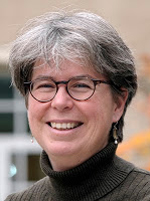For our sake he was crucified under Pontius Pilate,
he suffered death and was buried,
and rose again on the third day
in accordance with the Scriptures. — From the Nicene Creed
I could hear each and every voice, all 20 of us who had made it to Mass in the aftermath of last week’s epic blizzard, as we recited the Creed. The pastor, firmly starting us off, “I believe…,” the snow-suited youngsters in the back, the retired teacher across from me. We couldn’t let the tide of voices from a packed Sunday Mass carry us along. All of us were needed to bear the standard of the faith.
Last fall, I visited Antonio Gaudi’s magnificent church, La Sagrada Familia, in Barcelona. The words of the Apostle’s Creed, in many languages, are emblazoned on the walls of Sagrada Familia behind the main altar. I read this starkly simple statement of what we believe again and again — in English, Latin, Spanish and Catalan — each word taking on a new depth. Wondering at the way the bones of what we believe are built into the bones of this sacred place.
[hotblock]
The quiet strength of our voices last Sunday pushed me again into this sort of slow meditation on the creed, to think more deeply about what I was affirming, word by word. In particular, I heard anew the statement of the paschal mystery that anchors my faith: that Jesus suffered, died and rose again “in accordance with the Scriptures.”
The word we use in the English translation has changed with the new Roman Missal, from fulfillment to accordance. It struck me that the cor in accordance derives from the Latin word for heart, cor. Jesus’ coming, his death and his resurrection, was more than prophecy fulfilled, as the Gospel for the day proclaimed. Jesus’ sacrifice was of “one heart” with the Scriptures.
In retrospect, it’s obvious even without the new translation, how could Jesus, the Word made flesh, be anything other than of one heart with the Word we hear in the Scripture? But in this Holy Year of Mercy, it reminded me again that our faith principally resides not in a list of historical happenings, nor in a big book of rules, but the core of our faith lies in the heart. In the love of God, who as St. John reminds us, so loved the world that he gave to us his only Son. And so, with one accord, we pray and we believe.
To watch: Take a virtual tour of La Sagrada Familia.
To pray: The Apostles Creed
I believe in God,
the Father almighty,
creator of heaven and earth.
I believe in Jesus Christ,
his only Son, our Lord.
He was conceived by the
power of the Holy Spirit
and born of the Virgin Mary.
He suffered under Pontius Pilate,
was crucified, died, and was buried.
He descended into hell.
On the third day he rose again.
He ascended into heaven
and is seated at the right hand of the Father.
He will come again to judge
the living and the dead.
I believe in the Holy Spirit,
the holy catholic Church,
the communion of saints,
the forgiveness of sins,
the resurrection of the body,
and the life everlasting.
Amen.
***
Michelle Francl-Donnay is a member of Our Lady of Good Counsel Parish, Bryn Mawr.
PREVIOUS: Use a tool from St. Ignatius this Lent to see handprints of God
NEXT: Husband doesn’t know he’s dying; when should wife call for anointing?




Share this story